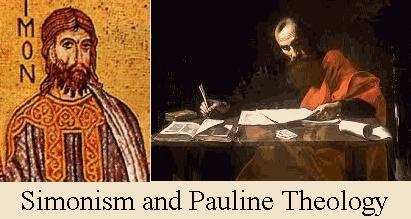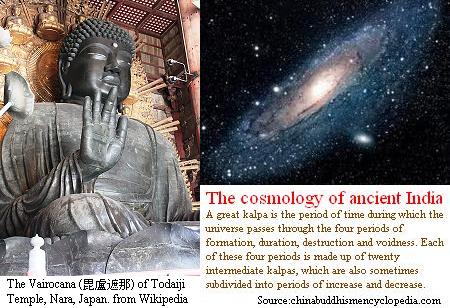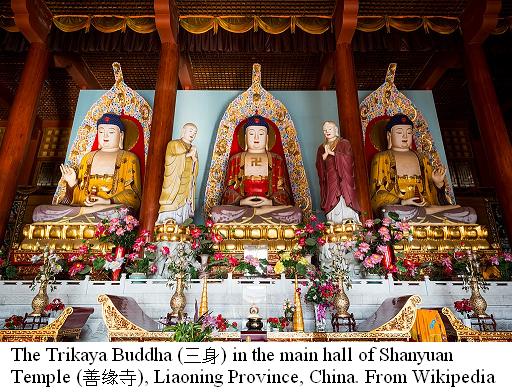|
||||||||
|
|
|
2018-07-02 ArtNo.46309
◆Review:The baptism of the Holy Spirit (Always be serious about this)
 After the Greek version of Old Testament was compiled in Alexandria, the leading cultural center of the Hellenistic world, under the tide of Syncretism (cultural fusion of east and west) which occurred following the east expedition of Alexander the Great in the late 4th century BC, Judaism spread to not only Asia Minor and North Africa, but also remote areas of the Roman Empire, such as the Iberian Peninsula and Britain Islands, as well as India and China at the eastern end of Silk Road, even possibly to Korea and Japan due to the missionary activities of enthusiastic evangelists, such as the members of the Synagogue of Freed Slaves. Therefore, ecclesias (churches for the non-circumcision gentile believers, who could not formally attend Synagogue) seem to have formed in many places around the Mediterranean Sea from far before the advent of Jesus Christ. ○Origin of Gnosticism  During this period, Judaism fused together with religions and cultures of Greece, Egypt, Persia, India and so on and then the tide of Gnosticism occurred. Aristobulus, a Hellenistic Jewish philosopher of the Peripatetic school, who lived in Alexandria in the 3rd or 2nd century B.C., attempted to interpret Judaism with Greek philosophy. His successor Philo merged Plato's philosophy with the Bible. Mr. James D. Tabor, Chair of the Department of Religious Studies at the University of North Carolina, says, "The Jewish philosopher Philo (c25 BC-47 AD) honored Plato, the great advocate of ascetic dualism, next to Moses himself." Being exposed such tidal wave of Gnosticism, Jesus started the religious reform movement through baptizing with the Holy Spirit, while Paul rebuilt the mythology of Judaism and established a very unique Pauline theology. According to the Acts of the Apostles and the Pauline epistles, after a Jew named Apollos, a native of Alexandria, went to Achaia, the Jerusalem church too dispatched their Missionaries. Then factional activities occurred in the Corinthian Church in Achaia, as factions of Apollos, Paul, Peter and Christ. (1 Corinthian 1:11-13/3:4) Paul violently condemned not only the Jerusalem church, which forced Gentiles to be circumcised, but also the faction of Apollos which had a Gnostic Background. As a result, Paul seems to have encountered opposition from both sides and to have been isolated.  Paul warns in a letter addressed to his disciple Timothy, "Turn away from godless chatter and the opposing ideas of what is falsely called knowledge (gnosis), which some have professed and in so doing have departed from the faith." (1 Timothy 6:20-21) But Valentinus, who is recognized as the founder of so-called 'Valentinian Gnosticism,' is said to have claimed that he learned Paul's secret teaching from Theudas, one of Paul's own disciples, and received from him some kind of apostolic sanction and authority. According to Mr. David M. Reis, Visiting Assistant Professor of Department of Religious Studies at the University of Oregon, Irenaeus (130-202), who was the Bishop of Lyons in Gaul in the second century, attacked the Valentinians hard, tracing their origins back to Simon the Magician rather than Paul. ○The evidence of children of light  Jesus told his disciples during the Last Supper, "When the Counselor comes, whom I will send to you from the Father, the Spirit of truth who goes out from the Father, he will testify about me. And you also must testify, for you have been with me from the beginning (of the world)." (John 15:26-27) Jesus says further on this subject, "If they say to you, 'Where have you come from?' say to them, 'We have come from the light. The light has been generated by itself and has not depended on others and appeared in their image (eikon).' If they say to you, 'Is it you?' say, 'We are its children, and we are the chosen of the living Father.' If they ask you, 'What is the evidence of your Father in you?' say to them, 'It is motion and rest.'" (Thomas 50) 'Light' indicates 'Supreme God' (propator:original Self). According to Mr. Sasagu Arai, author of the Japanese version of The Gospel of Thomas, a sect so called 'Nahash,' one of the Gnostic factions, explains that the supreme god, who is never moved by others, is 'Sabbath,' and what is not moved by others gives movement to everything. Therefore, the evidence of the chosen of the living Fatheru is motion and rest. ○Realization of the kingdom of God  Jesus further said, "Blessings on those who are alone and chosen, for you will find the kingdom. For you have come from it, and you will return there again." (Thomas 49) According to Mr. Sasagu Arai, 'one who is alone and chosen' means 'one who transcends division and recovers the original integration (propator = original Self) in himself.' And the reign of original Self means realization of the kingdom of God. Jesus taught a Samaritan woman drawing water, saying, "Yet a time is coming and has now come when the true worshipers, who are reborn of the Spirit, worship the Father in spirit and truth, for they are the kind of worshipers the Father seeks. (John 4:23)" As long as one worships in spirit and truth, the place, where he is worshipping, is none other than Jerusalem, Mecca or the Mount Grdhrakuta (The Vulture Peak) and it is needless to rebuild Israel or Islamic countries. For a time is coming when the One World, the reign of the Holy one of God, will be realized and there will be no differences among countries such as Japan, China, America and among religions such as Jew, Christian, Muslim and Buddhist. Jesus tells us, "Open your eyes and look at the fields! They are ripe for harvest. Even now the reaper draws his wages, even now he harvests the crop for eternal life, so that the sower and the reaper may be glad together. (John 4:35-36)" ○A stem of rice plant and a stack of millet.  Time passed to the late Tang Dynasty China, a monk asked Zen Master DongShan LiangJie (洞山良价807-869): "What are the teacher of Vairocana and the master of Dharmakaya?" Vairocana is a name of Buddha symbolizing the universe in Sanskrit. As an embodied truth, it is also called Dharmakaya in Sanskrit. This monk seems to have challenged DongShan and have requested to show him DongShan's original Self ('original face' in terms of Zen Buddhism) as the teacher of Vairocana and the master of Dharmakaya. In response to this challenge, DongShan answered, "A stem of rice plant and a stack of millet." DongShan seems to have said, "Here you are," and have thrown a straw that was in his hand just at that time to the monk. But there might haven't been yet a plastic straw at that time. ○Not fall into ZhongShu (衆数)  The monk then asked to answer corresponding to theological doctrine of the 'Triple Body of Buddha,' saying. "In the triple body which does not fall into the worldly fate?" According to the philosophy of Hua-yan (華厳哲学), Dharmakaya (法身) symbolizes the absolute truth or Li (理: universality) transcending space and time. In contrast, Nirmanakaya (応身) means the Savior descending into this world or Shi (事: particularity) which is under spatial and temporal limitations, in other words, actual Buddha in the history. It seems that there were only Dharmakaya and Nirmanakaya in its early days of the Mahayana Buddhism. However, after Naagaarjuna (龍樹菩薩:150?-250?) had written the book titled 'The Treatise on the Middle Way (中論)' and Hui-wen (慧文550-577), the founder of Tiantai (天台) Buddhism, had preached the theory of triple truth (三諦), namely, the truth of emptiness (空), the truth of temporariness (仮) and the truth of mean (中), seems to have introduced the third Body of Buddha, that is, 'Sambhogakaya (報身)' to symbolize interfusion between Li (理: universality) and Shi (事: particularity). This monk asked which of triple body was not able to fall into ZhongShu (衆数). ZhongShu is almost same meaning of Masses (大衆) or Sentient beings (衆生). Thus, he asked, "In the triple body which does not fall into the worldly fate such as causal response (因果応報) or four attributions of the life, that is, birth (生)、aging (老)、sickness (病)、and death (死)?" Incidentally, the monk asks DongShan slight differently in a book titled 'Shinji-shobogenzo (真字正法眼蔵)' written by Dogen Zenji (道元禅師1200-1253), the founder of the Japanese Soto Zen School (曹洞宗), saying, "Do you preach through which one of the triple body?" ○I've always been serious about this.  DongShan responded, "Good question, I've always been serious about this." A few days later, while washing his bowl DongShan was watching two crows fighting over a frog. Just then the above-mentioned monk happened to come along and asked, "Why should they reach such a state?" Then, DongShan just said, "Because of you." DongShan meant that it is his own fault that crows fight over a frog as well as the Third World War breaks out for one who becomes a single one (Autogenes) being unified with the universe through spiritual rebirth. Therefore, he should proceed everything and every moment as if he treads on thin ice regardless on which body. When ZhaoZhou CongShen (趙州従諗778-897), asked TouZi DaTong (投子大同819-914), "How is it when a man who has died the great death returns to life? " TouZi replied, "He must not go by night: he must get there in daylight. At least he should bring a lantern." (Blue Cliff Record Case 41) <To be continued> [Reference] ○《Jingde Chuandeng-lu, Part 15》 While washing his bowl the Master was watching two crows fighting over a frog. A monk came up and asked him: "Why should they reach such a state?" "It is simply because of you," answered the Master. A monk asked: "What are the teacher of Vairocana and the master of Dharmakaya?" "A stem of rice plant and a stack of millet." answered the Master. "In the triple body which does not fall into the worldly fate?" asked the monk. "I often think about it," replied the Master. (Translated by Chang Chung-Yuan) ○《Shinji-shobogenzo: Case 55》 A monk asked DongShan: "Do you preach through which one of the triple body?" Master said: "I've always been serious about this." ○《The Blue Cliff Record: Case 41》 ZhaoZhou asked TouZi, "How is it when a man who has died the great death returns to life? " TouZi said, "He must not go by night: he must get there in daylight."  ○What is "Baptism with The Holy Spirit"? According to the dialectic of the Gospel of John, 【Thesis】"A man can possess eternal life through accepting testimony of the Son of man and being baptized by him." (John 5:24) 【Anti-thesis】But "The one who comes from the earth cannot accept the testimony by one from heaven." (John 3:32) How then can a man possess eternal life? 【Synthesis】"If you want to be baptized with the Holy Spirit, you can just go back to the word which was with God in the beginning (John 1:1) and certify that God is truthful. (John 3:33)" When he said, "You are Huichao," Zen Master Fayan thrusted vivid Self in Huichao in front of his eyes. Purchase here ○One world:The aim of SEAnews ◆Recruitment of Ad-SEAnews CanvassersYour Comments / UnsubscribeSEAnews TwitterSEAnews MessengerSEAnewsFacebookSEAnewsGoogleSEAnews eBookstoreSEAnews eBookstore(GoogleJ)SEAnews world circulation |
|
[Your Comments / Unsubscribe]/[您的意见/退订]/[ご意見/配信停止]
Please do not directly reply to the e-mail address which is used for delivering the newsletter. 请别用递送新闻的邮件地址而直接回信。 メールをお届けした送信専用アドレスには返信しないで下さい。 |